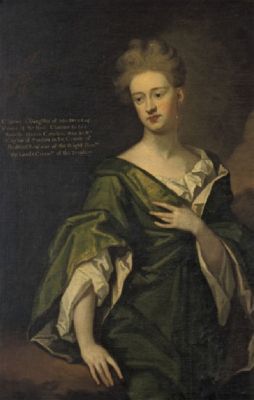Charlotte Clayton, Baroness Sundon facts for kids
Quick facts for kids
Charlotte Clayton, Baroness Sundon
|
|
|---|---|

Portrait by Godfrey Kneller, c. 1730s
|
|
| Born |
Charlotte Dyve
11 December c.1679 |
| Died | 1 January 1742 Cleveland Row, London
|
| Nationality | British |
| Occupation | Courtier |
| Spouse(s) | William Clayton, 1st Baron Sundon |
Charlotte Clayton, Baroness Sundon (born around 11 December 1679 – died 1 January 1742) was an important British lady who worked for the royal family. She was known for being a close friend and trusted advisor to Queen Caroline, who was the regent (ruling in place of the king) at the time. Her influence was so great that some people, like the powerful politician Robert Walpole, worried she might be using her position for personal gain.
Contents
Life of Charlotte Clayton
Early Years and Family Connections
Charlotte Dyve was born around 1679. Her father, John Dyve, worked for the Privy Council, which was a group of advisors to the king. Her mother was Frances Wolseley. Charlotte's grandfather was Sir Lewis Dyve.
Before August 1714, Charlotte married William Clayton. He was a government official who worked for the Treasury. He was also a Member of Parliament (MP) and helped manage the interests of the powerful Duke of Marlborough. In 1735, William became the first Baron Sundon of Ardagh, which meant Charlotte became Lady Sundon. They did not have any children.
Working for Queen Caroline
It is believed that the Duchess of Marlborough helped Charlotte Clayton get a job at the royal court. From 1714 until 1737, Charlotte worked as a woman of the bedchamber for Queen Caroline. This was a very close and trusted position.
Charlotte became very good friends with Queen Caroline. The Queen often served as regent, meaning she ruled the country when the king was away. Because of their close friendship, Charlotte had a lot of influence with the Queen.
Influence and Challenges
Charlotte's strong influence worried important politicians like Robert Walpole. He was a very powerful leader in the government. Walpole suspected that Charlotte was using her close relationship with the Queen to help people in exchange for gifts. For example, he once accused her of accepting a pair of earrings to help the husband of Henrietta Fermor, Countess of Pomfret.
Walpole also believed that Charlotte's opinions were making the Queen difficult to work with on important government matters. Some people even claimed that Charlotte suggested she and Walpole could rule the country together!
Later Life and Passing
The death of Queen Caroline was a very sad event for Charlotte. In her final years, Charlotte suffered from a painful illness.
She passed away on January 1, 1742, at her home in Cleveland Row, London. She was buried at Sundon Hall.

